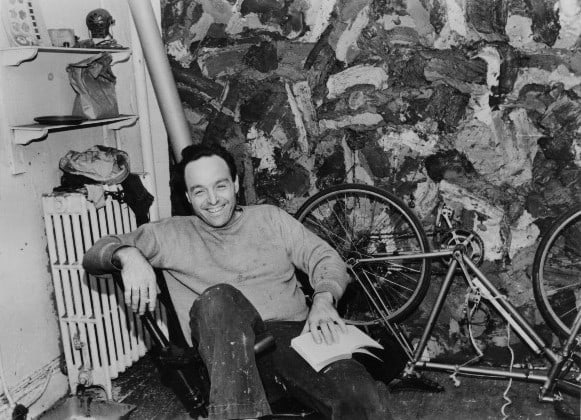September 3 – November 2, 2024
Al Held: Works on Paper, 1960 – 1989
September 3 – November 2, 2024
Al Held: Works on Paper, 1960 – 1989

Al Held, 60-277, 1960, India ink on paper, 18 x 23 3/4 inches
McClain Gallery is pleased to open Al Held: Works on Paper, 1960 – 1989, a focused exhibition of the artist’s drawings. Spanning almost three decades, the works trace the evolution of Held’s painting practice during this period, reflecting the gradual shifts and refinements in his approach. These changes are made evident in the different functions drawing and sketching came to play for the artist, first as a warm-up exercise and research tool to find new shapes and approaches into the pictorial plane, then as a preparatory tool for the immensely complex late paintings.
Known for his keen spatial abstraction, Al Held succeeds the New York school Abstract Expressionists closely. Expressive geometric shapes make up his early work - loose and gestural but with an eye toward the Platonic. Slowly, Held introduces “restrictions” into his practice, rules that allowed him to push the history of modern painting.
Our show opens with six ink drawings, created during the same period as the famous Taxi Cab paintings – one of which is in the collection of Museum of Fine Arts, Houston. These are followed by two graphite sketches from 1967, wherein the work takes on volumetric space and dimensional geometry via hard lines that expand space in the pictorial plane, an exciting break from the “flatness of the picture plane” imposed by Greenbergian painting customs. The rest of the exhibition travels through the 1970s and 80s, following Held as he floats polygons and other volumes in three-dimensional non-objective compositions: while a sense of spatiality exists in the work, there is no inherent meaning held by the shapes, and the work remains fully abstract, a sort of physical abstraction accessed only through one’s mind.
"One of the catchwords in my mind to motivate [the work] was presence. Things had to have that presence. In other words, it was a big problem of how to make an abstract painting have an experiential presence. It wasn’t just a mental activity. It wasn’t a game or game plan or a plotting out of things. So painting had an existence as a tactile experiential object that one was looking at, standing in front of. And in this kind of extreme, reduced situation, how does one do that?…[W]hat these paintings represent, is that kind of simple statement not to allow anything to be ambiguous."
– Al Held, interviewed by Irving Sandler in 1987, as quoted in White Cube’s Al Held ‘Selected Works 1956–2004’ from 2022.

New York studio, 1957
Photo by Sam Francis
The show finishes with one of Al Held’s brilliant watercolor works, made while living abroad in Italy, where he would study Renaissance art for the first time and return yearly for the rest of his life. This work is exemplary in its saturation; other artists and critics of his time were surprised by the bold new direction and the Rococo nature of the colors he brought back with him from his trips to Umbria. The masterful play of forms and hues on the fibers of the page are a testament to Held’s experimental, life-long practice. Together, these works bolster Held’s legacy as a pioneer and his risk-taking as he steered the reins of Abstract Expressionism and its successors toward brave new worlds.
We are grateful to Daniel Belasco and all at the Al Held Foundation for their support and friendship.
WORKS IN EXHIBITION
BIOGRAPHY

Al Held in his Fifth Avenue studio, New York, with Circle and Triangle (partial view), 1964.
Photo Manfried Tischer.
Primarily known as a pioneer of Hard-Edge Abstraction, Al Held (1928–2005) continuously evolved his abstract painting towards greater complexity in order to formulate unseen truths. Born in Brooklyn in 1928, Held studied at the Art Students League in New York, aspiring to paint social realist murals. While working in Paris from 1951–53, he began to identify as a second generation Abstract Expressionist. Throughout the 1950s he painted heavily impastoed canvases, determined to give structure to gesture. By the end of the decade Held began using acrylic paint for geometric shapes, giving his paintings a hard-edged clarity. The resulting series, most famously the Alphabet paintings of the 1960s, established his signature style of monumental specificity.
Among Held’s notable accomplishments are major public artworks in Philadelphia, Washington, D.C., New York City, Orlando, and elsewhere. He had solo exhibitions at the Stedelijk Museum (Amsterdam), San Francisco Museum of Modern Art, Institute of Contemporary Art (Boston), Corcoran Gallery of Art (Washington, DC), and the Whitney Museum of American Art (New York). His work is in the collections of scores of museums and public collections. Held taught painting and drawing from 1963 to 1980 at the Yale School of Art.











































